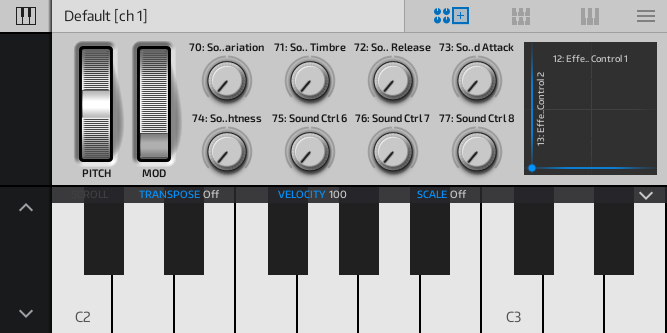

Overview
PERFORM
SETUP
The External MIDI Instrument is used to control and play an external MIDI device.
  |
Quick links: Overview PERFORM SETUP |
Use the External MIDI Instrument to add a track to your project which plays an external MIDI device.
The External MIDI Instrument simply sends the track's MIDI messages (such as note and controller events) to the device. It doesn't handle audio output from the external device and doesn't produce any audio of its own.
The MIDI device can be:
The perform page is accessed by enabling the PERFORM tab button (highlighted in GREEN in the image below).


Use the VIEW BUTTONS on the right of the title bar to select the desired view:
MACROS |
Dedicates the top half of the performance page to the macro controls and the bottom half to the keyboard. When the macro controls are visible, tap the HAMBURGER BUTTON in the top right corner of the perform page to invoke the Macro Tools menu. |
|
DUAL KEYS |
Shows two keyboards. | |
FULL KEYS |
Dedicates the entire performance page to a single large keyboard. |
You can access settings for the keyboard by tapping on the button highlighted in GREEN in the image below.

Use the bar to lock or unlock HORIZONTAL SCROLLING or to set the keyboard's TRANSPOSE, VELOCITY or SCALE.
Any settings you change via the bar are applied globally to all keyboard-based instruments in the project.
You can change the width of the keys in the Settings page.

The perform page has 10 macro controls, consisting of 8 rotary knobs and 2 X/Y pad axes. A macro control may be mapped to any MIDI controller.
When the macro controls are visible, tap the HAMBURGER BUTTON in the top right corner of the perform page to invoke the Macro Tools menu.
 |
Use the menu to initialize, swap or rename macro controls, or to map them to a MIDI controller. |
The setup page is shown when the PERFORM tab button (highlighted in GREEN in the image below) is disabled.


| MIDI OUTPUT DEVICE | Sets the device that the instrument will send its MIDI messages to. | |
| MIDI OUTPUT CHANNEL | Sets the MIDI channel that will be used for all output. If you want to output MIDI to more than one channel of the device then you can use another External MIDI instrument. | |
| MIDI THRU | When enabled, the instrument will pass all events it receives from the track's MIDI input to the external MIDI device in addition to the events being played by the sequencer. When disabled, it only sends the events being played by the sequencer. If you're using the same MIDI hardware as both your controller and your sound module (eg. a an external synth) then you'll probably want to turn this off to avoid note doubling if the synth doesn't have its own 'MIDI local control off' setting. |
|
| LATENCY COMPENSATION | Shifts the output MIDI events forwards or backwards in time to compensate for latency differences between the app and the external device. Note: If you shift events forwards in time beyond the red section, then the app may have to add additional audio latency to achieve the desired latency compensation. |